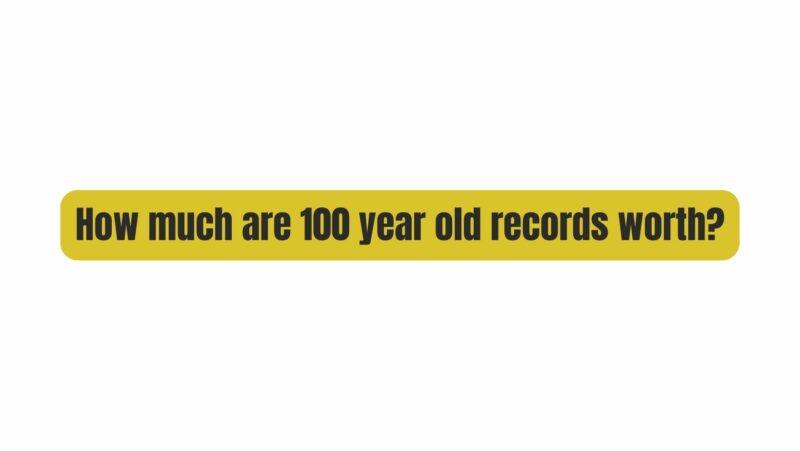In the age of digital music streaming and instant downloads, there exists a remarkable nostalgia for the analog era of music. Vinyl records, in particular, have seen a resurgence in popularity among audiophiles and collectors. Yet, while contemporary vinyl records are relatively easy to come by, there is an undeniable allure associated with 100-year-old records. These century-old relics not only offer a glimpse into the past but also possess considerable value in today’s collectors’ market. In this article, we will delve into the fascinating world of century-old records and explore just how much they are worth.
The Historical Significance of 100-Year-Old Records
To understand the value of 100-year-old records, it’s essential to appreciate their historical significance. The early 20th century marked a pivotal period in the evolution of music recording technology. During this era, records transitioned from shellac to vinyl, and recording techniques evolved significantly. Many of these early records capture performances that are not only musically important but also historically significant.
- The Birth of Commercial Recording: The late 19th and early 20th centuries witnessed the birth of the commercial recording industry. Pioneering companies like Victor and Columbia began producing records, allowing musicians to reach a wider audience.
- Jazz and Blues: The 1920s saw the emergence of jazz and blues, with legendary artists like Louis Armstrong and Bessie Smith recording their groundbreaking works. Original recordings of these artists have become highly sought-after collector’s items.
- Early Rock ‘n’ Roll: The 1950s brought rock ‘n’ roll to the forefront of music, with Elvis Presley, Chuck Berry, and Buddy Holly making their mark. Records from this era are cherished by collectors for their cultural impact.
The Rarity Factor
One of the primary reasons 100-year-old records can be so valuable is their rarity. Over the decades, many records have been lost, damaged, or discarded. As a result, finding well-preserved, century-old records can be a challenge. This scarcity drives up their market value.
- Limited Pressings: Records from the early 20th century often had limited pressings, making them rare from the outset. This is especially true for recordings of lesser-known artists and niche genres.
- Fragility: The materials used for early records, such as shellac, were fragile and susceptible to damage. Records that have survived the years in excellent condition are highly prized.
The Collector’s Market
The value of 100-year-old records is intricately tied to the collector’s market. Collectors, whether driven by a passion for music or the desire for rare artifacts, are willing to pay significant sums for these records.
- Condition Matters: The condition of a record is paramount in determining its value. Mint or near-mint records with little to no scratches or wear fetch the highest prices. Collectors often seek records with original sleeves and labels in good condition.
- Artist and Genre: The artist and genre of the record can greatly influence its value. Records by iconic artists or within influential genres tend to command higher prices. For example, a 100-year-old jazz record by Louis Armstrong may be worth considerably more than a lesser-known classical recording from the same era.
- Historical Significance: Records that played a pivotal role in music history, such as the first-ever recordings of a particular style or artist, are highly coveted by collectors and museums.
Notable Examples
To illustrate the potential value of 100-year-old records, let’s look at a few notable examples:
- Robert Johnson’s “Cross Road Blues” (1936): This blues record, by the legendary Robert Johnson, is considered one of the most valuable in the world. In 2013, a copy sold for over $80,000 at auction.
- The Beatles’ “Please Please Me” (1963): While not quite 100 years old yet, early Beatles records are already highly sought after. A rare copy of “Please Please Me” signed by all four band members sold for over $50,000 in 2020.
- Enrico Caruso’s “Vesti la Giubba” (1907): This early opera recording by Enrico Caruso is considered one of the earliest examples of classical recording. Mint-condition copies have sold for thousands of dollars.
Preserving the Legacy
Preservation efforts play a significant role in maintaining the value of 100-year-old records. Organizations and individuals dedicated to restoring and archiving these vintage recordings ensure that future generations can appreciate the music of the past. The digitization of old records has also made it possible for a wider audience to enjoy these historical treasures.
Conclusion
In the world of music and collectibles, 100-year-old records are not just relics of the past; they are windows into a bygone era of sound and culture. The value of these records goes far beyond their monetary worth; they hold historical, cultural, and artistic significance. Whether you stumble upon one in your attic or seek to explore the world of record collecting, remember that these century-old gems have the power to transport you through time and music, making them priceless in their own right. So, the next time you encounter a dusty old record from yesteryear, take a moment to appreciate the history it holds and the stories it can tell.


